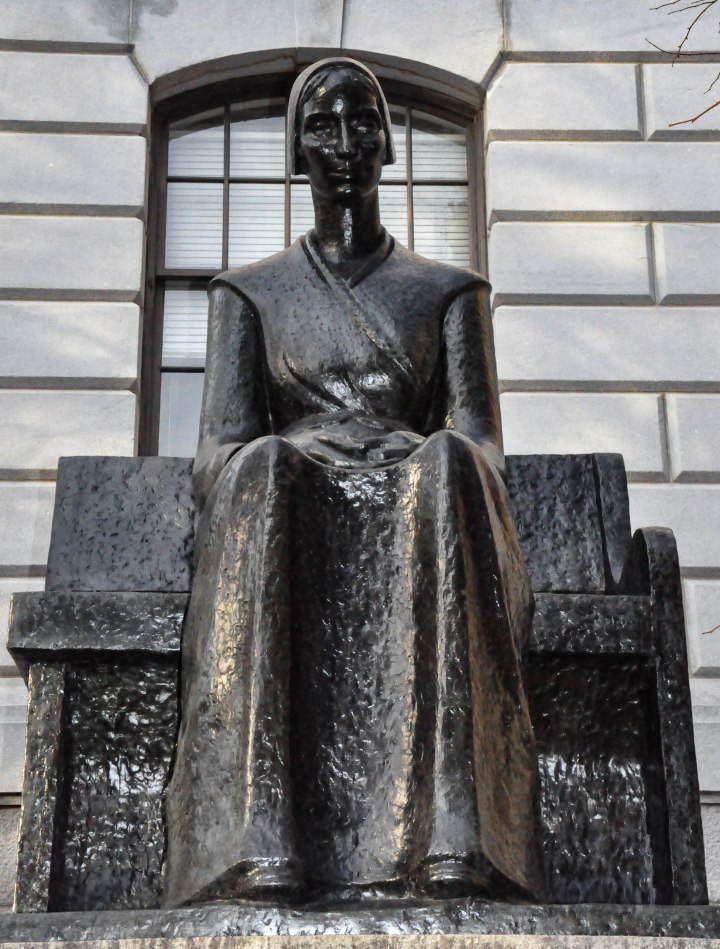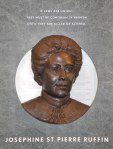London, England
The idea for this blog (the whole blog, not just this post) started back in 2010, when I was visiting St. Paul’s Cathedral in London, an exquisite space of famous architecture and history. Below the main area, there is an underground crypt filled with monuments and statues. I was standing in that crypt the moment it occurred to me that I wasn’t seeing anything about women. There were many beautiful memorials to noblemen, military men, and men of civic honor, but I looped around the crypt twice looking for something that primarily honored the life of a female and found nothing. Wondering if I was on to something, I climbed the stairs back up to the main floor and found two chaplains (one female, one male) who appeared to be standing around waiting to answer questions and asked, “Are there any memorials in the crypt to women?” The male chaplain immediately chirped up and said, “Oh yes! There are several women buried alongside their husbands!” As I stifled my desire to laugh, and having never mastered the English skill of the expressionless face, I was relieved when he was interrupted by the female chaplain, whose own face reflected the long suffering look of a person assigned to watch over the village idiot. She quickly interjected, “But of course, that’s not what she’s asking.” Indeed, it was not. She thought about it for a few minutes, and concluded the answer was “No.” Then she thoughtfully tried to point me in the direction of statues in the city that might celebrate women, and was able to recall one that featured Florence Nightingale, and several that featured Queens Victoria or Elizabeth. We both ended the conversation by looking at one another and saying, “Huh.”
Paris, France
As it turns out, on that particular trip I ended up leaving London and heading to Paris, with the same question in my mind. Are there statues memorializing women in Paris? That trip was only for a few days, but I was able to find many, many female statues in Paris that were all either Lady Liberty, or the Goddess of So and So, and lots of statues of the Virgin Mary, but only one of a historical figure that didn’t give birth to the baby Jesus: Joan of Arc. We all know how that ended.
Boston, Massachusetts
I like to think all of my revelations in life are original ideas, but as it turns out, women in the U.S. were already noticing the stories of women were not just missing from history books, but from public spaces. In 1989, a group of Boston Public School teachers, librarians, and students sought to change that, and inaugurated the Boston Women’s Heritage Trail. The city already has the Freedom Trail, and the Black Heritage Trail, but the Boston Women’s Heritage Trail focuses exclusively on the historical contributions of women in Boston. The format of the BWHT is a series of maps that are available either online, or by purchasing a book that outlines seven walks you can take through the city to visit either monuments or places of historical significance to the contributions of more than 200 women in the city. I spent an afternoon walking a part of this trail for myself, and in the spirit of my original question, I focused on statues and monuments.

Boston Women’s Memorial
My son joined me for the day, and we started at the Boston Women’s Memorial in the Back Bay area. This memorial is located on Commonwealth Avenue and Fairfield Street, and was installed in 2003 to commemorate three literary women:
Abigail Adams is famous primarily for her

correspondence and trusted advice to her husband, President John Adams. Their letters continue to be read today, providing an intimate look at their lives, as well as a first hand account of the politics of their day. Abigail also educated and supported the career of her son, John Quincy Adams, who when on to become the fourth American President.
Lucy Stone was a famous editor and suffragette. When I read biographical notes about Lucy, she seemed to me to be the Gloria Steinem of her day. Educated and outspoken, when it came to the casting of women as second class citizens, Lucy wasn’t having it. In 1858, Lucy spoke up to remind American of the “no taxation without representation” principle; in short order her refusal to pay property taxes resulted in the seizure and sale of her household goods. Undaunted, she traveled to Kansas in support of the women’s suffrage movement, and later served as the president of the New Jersey Women Suffrage Association. She helped organize the New England association,and served on the executive committee of the American Equal Rights Association.
As I was reading about Lucy, I noticed something interesting about the women’s suffrage movement in America; there seemed to be a lot of different competing organizations and plenty of evidence of philosophical differences regarding how radical the movement should be, who should be in charge, and what the message should be. It appears the women of the 19th century were just as passionate about their rights as women are today, and despite those differences they somehow managed to keep pushing forward. That was encouraging.
That tension was clearly in place when Stone, Julia Ward Howe and others founded the American Woman Suffrage Association (AWSA). Stone took up the position as editor of its publication, the Woman’s Journal, which became the premier publication for women’s rights of its day.
Lucy Stone was the only woman I found to be memorialized in both stone and/or bronze in three places (there might be more, I don’t know.) There is also a bust of her in the State House, and another in Faneuil Hall.
Phillis Wheatley was the first African American published poet. Phillis was seized from Senegal/Gambia, West Africa, when she was about seven years old, and enslaved in Boston by a family who taught her to read and write. Extraordinarily intelligent, she took every opportunity to educate herself, and by the age of 13 was a published poet. Her life and literary contributions flew directly in the face of claims that a person could be cast as intellectually inferior based on gender or race.
On Being Brought from Africa to America

Make Way for Ducklings Sculpture – Boston Public Garden
I have passed this sculpture many times and never thought of it as a feminist memorial, but the day we visited, the ducks were adorned with pink pussy hats in honor of the upcoming Women’s March on Washington. This was causing a lot of people to stop, smile and photograph. Also of note is the female sculptor, Nancy Schön.
The Boston State House
There are several statues and memorials to women both in and around the Boston State House. Out in front are sculptures of two women who lived in the 17th century, were friends, and had the courage to speak up to the religious leaders of their day, advocating that both women and men had equal footing in the eyes of God. One was exiled, and one was publicly executed.

- Anne Hutchinson believed that both men and women could receive grace only from God, and she accused the ministers of preaching that “good works” signified holiness instead. Women were attracted to the prayer meetings she held in her home partly because her beliefs put women’s souls on an equal footing with men’s souls. As you can imagine, that was not a popular view amongst the men of power in her time. She was a respected midwife and wife of an established merchant, but was banished from Boston in 1638 for heresy.
- Mary Dyer was a Quaker whose beliefs were similar to those of Hutchinson. Mary had that going against her, plus she was a Quaker, and the Quaker religion was not allowed in Massachusetts at that time. Mary refused to be silenced, despite being banished twice from Boston. The third time she spoke up, she was hanged on Boston Common. This statue is quite poignant, I think due to it’s placement overlooking the Commons.

Inside the State House
In 1996, the Massachusetts legislature noticed that the State House art collection included primarily white men (shocker), and the State House Women’s Leadership Project was launched. A new work of art was created specifically to honor the contributions of women to public life in Massachusetts. It is a series of two-toned marble panels which carry the words written by the women honored, placed above stone and bronze busts cast from period photographs. The women featured are a combination of scientists, abolitionists, civil rights and labor movement activists, and suffragettes: Dorothea Dix (1802-87); Lucy Stone (1818-93); Sarah Parker Remond (1814-94); Josephine St. Pierre Ruffin (1842-1924); Mary Kenney O’Sullivan (1864-1943); and Florence Luscomb (1887-1985). You have to either ask or look around a bit to find it, but it’s on the far side of Doric Hall (outside in the hallway). I found this mural interesting because it introduced me to some women I hadn’t heard of, and I appreciate very much that it found a home here, but overall it had a bit of a feel of “there, we fixed that” to it. A more prominent placement in the State House would have probably landed better with me, and lumping all of these women together, when each was a worthy of being featured individually, felt a little gratuitous. Then again, it’s possible I should just get off my high horse and enjoy it.
There is a very beautiful and moving statue in the Nurses Hall which serves as a tribute to the Civil War nursing corps. “Angels of Mercy and Life Amid Scenes of Conflict and Death,” was sculpted by Bela Lyon Pratt and depicts a nurse on a battlefield, supporting a fallen soldier. Nurses are common in the military today, but in the 19th century it was exceptional for a woman to become a nurse, and even more so for them to have served on a battlefield. The monument was dedicated in 1914, and is considered to be only one of two known to be dedicated to the female Civil War nurses.

Faneuil Hall
We ended the tour here, and spent some time talking to the National Park Service Rangers. They were able to tell us several stories about meetings held in the hall for the women’s suffrage movement, and as it turns out, one of the Massachusetts Senators was planning a rally there the following week in support of the Affordable Care Act (the female senator). I though it fitting that our day ended at one of Boston’s oldest monuments, which is a place that is still providing space for the exchange of ideas and the rallying of people towards our causes.
Overall Impression: The BWHT has a downloadable app for their walks, and while I didn’t download it for this visit, I will definitely do that the next time I visit. Boston is a walking town, and the Boston Women’s History Trail is a fantastic compliment to the Freedom Trail, or the Black Heritage Trail. All of the trails include points that are just a quick stop, like buildings where someone lived or something important happened, as well as destinations that are worth spending more time to investigate. I left thinking it would be great to head back in the spring with a group of women and an official guide to do one of the sections of the BWHT in the morning, and then some other activity in the afternoon. The National Park Service Rangers at Faneuil Hall were very knowledgeable and helpful.
Cost for the Day:
Parking: $29
Lunch: For 2 at the Cheesecake Factory in Prudential Square area, $50
Dinner: For 2 at Legal Sea Foods, Long Wharf, $100
Subway back to parking area: $2.75
















